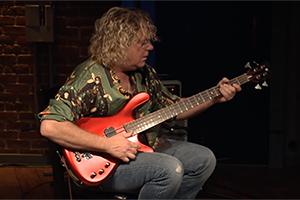Multi-faceted bassist extraordinaire describes his “best of” compilation
Exclusive interview with FBPO’s Jon Liebman
November 4, 2019
Stuart Hamm is widely known for his extraordinary and innovative technique on the bass guitar, including jaw-dropping two-handed tapping and funk-style slapping and popping. As a leader, Stu has released several critically acclaimed recordings, including Radio Free Albemuth, Just Outside of Normal, The Book of Lies, and 2018’s The Diary of Patrick Xavier. Stu has performed and/or recorded with the likes of Steve Vai, Joe Satriani, Frank Gambale, Steve Smith, Richie Kotzen, Michael Schenker, and many others. His brand new release, Artspoke: The Best of Stu Hamm 2007-2018, is being released in November 2019.
FBPO: Let’s talk about your new record, Artspoke.
Stu: Artspoke! I’ve done four records with my friend, the producer, James Boblak, and the name of his studio and media company is Artspoke. I wanted to commemorate all the work we’ve done together, the four records. The last record I did was The Diary of Patrick Xavier, which was the completely solo bass record, you know, pretty mellow. The next record that I’m writing is a little more prog rocky. But I’ve been so busy traveling, and sometimes the music comes easily, and sometimes it comes a little slower. This (one) was coming a little slower, and I wanted to get something out to keep the fans busy and to sell at gigs. It’s a nice collection of tunes, a nice sequence of songs.
FBPO: Listening to all those tunes was like going down “Memory Lane” with Stu!
Stu: [Laughs] Well, there you go! And also, an introduction to some people that may not know what I’m all about, so I’m very excited. This new cat, Brendan Fitzpatrick, started this new label called Guitar One records. He does a bunch of stuff for TV shows and movies, sort of incidental music, and he’s put out some sort of bluesy, rock guitar records that I’ve played on. He was interested in starting a record label, and this is his first go at it. We talked about what he wanted to do, and I said it sounds like a great idea. He was very instrumental in facilitating getting this done. It’s just a cool little strange mixture of music, some of the live stuff and some of the solo stuff from The Diary of Patrick Xavier, and of course the hits that people (know). A lot of times, people come (up to me) after the show and they say, “Wow, man, that sounds great! Do you have it on a record?” And now I have a record that has what has become a staple of my live performances, which is “Going to California” and “Lucky in the Sky with Diamonds,” and “Flow My Tears,” and “Lone Star,” and “Smoke Break,” and “The Obligatory Boogie.” Now they’re all available in one easy location!
FBPO: You’ve amassed quite a library over the years. Did you have any trouble narrowing it down to the eleven tunes on this record?
Stu: I sure did! And it’s super hard to figure out how to sequence it, because I think I’ve changed over the years. I’m (no longer) the guy that wrote “Kings of Sleep” and wore thigh-high boots, the big fireman’s jacket and big, giant hair. And part of me wanted to put out a record that would sort of reflect where I am now, (with the) much more mellow, and sort of post-modernist, minimalist music that I listen to. But I’ve still got a lot of fans that know me from Satriani, and that’s a significant part of my buying audience and fans, right? So that’s why I put “The Obligatory Boogie,” which features Satriani on guitar. You gotta put some of the rock stuff on there.
FBPO: A couple of the tunes on this record go all the way back to that big transcription project you and I did together in the early ‘90s, specifically, the original “Flow My Tears” and “Lone Star” with Eric Johnson, but they’ve both been re-recorded.
Stu: Yeah. “Lone Star” was written for Eric Johnson, specifically. You hear the legendary stories about him hearing the difference between Eveready batteries and Duracells and stuff. And, being in the studio, I can confirm that all of that is true. He would take the cords out of the patch bay and turn them around. Occasionally, you could hear a little more high end. All that stuff makes a difference. And the only thing that matters is that if it makes a difference to him, it makes him play better. That’s all that really matters, right?
FBPO: Who played guitar on the re-recorded version?
Stu: On the re-recorded version is my good friend Jude Gold, who was the head of the guitar department at MI (Musicians Institute) when I was head of the bass department. Jude also plays the melody on the song “The Obligatory Boogie” before Joe Satriani comes in and starts playing the solo. Jude is currently out with Jefferson Starship, and I see him often around LA. He’s just a great, all-around guy.
FBPO: Tell me about your gear.
Stu: I’m still playing my wonderful Warwicks. For years I’ve been playing this green prototype of the Stu Hamm signature bass, and I played it to death, literally. On the new bass, the wood and whatever “mojo” is in that bass is incredible! This bass, man, the wood, and the neck, and the action, it’s just friggin’ perfect!
FBPO: EMG pickups, right?
Stu: I’ve been with EMG forever. I’ve known Rob Turner and Tommy Armstrong forever and ever and ever.
FBPO: What else are you using?
Stu: I’ve been playing GHS strings so long, that I’ve been with them longer than the current president of the company has. Have you been to the factory?
FBPO: Yes!
Stu: I guess people assume that there’s a machine that coils the strings and puts them in a packet, but that is a human being. It’s incredible. Unbelievable. I just use Boomers, 45 to 105. GHS is finally making the nylon, tape-wound strings again, which are great! I use those on my fretless basses, and they give it a really warm, acoustic sound.
And I’ve got a new Stu Hamm MarkBass amp. What I tried to do was make a rock version of the MarkBass. The cabinet has got two 15s, and I was not convinced that the 15s would have enough clarity, but they have just as much if not more clarity than the 4x10s that I’ve always played, but a lot more low end. And it sounds great!
I’ve been using this company Wire World that makes really, really great cables. I met these guys and they build me these amazing, amazing cables.
FBPO: What advice can you impart to somebody who wants to learn bass?
Stu: When you and I were transcribing “Flow My Tears” and all that stuff, literally no one played that way. I didn’t invent tapping on the bass, but maybe I did. I got to a lot of stuff before a lot of people did. But when you think about it, when I was 16, maybe five people in the world slapped on the bass, three people played harmonics, no one really played chords, maybe a few people did. But now, by the time a bass player is 16, they’ve got to be able to slap, to tap, play chords, play harmonics, and do this whole vocabulary that just didn’t exist, really, when we were kids. And that’s great, but if you get caught up in that, again, if you’ve never had to play “Moondance” or “Killer Joe” or “Billy Jean,” that’s really what bass playing is. The other stuff is cream on the top.
It’s so weird for people that know me from all that excessive, you know, tapping “Moonlight Sonata,” don’t know that I play upright, that I can swing my ass off, that I can read really well, read treble clef and sight read pretty much any chart you put in front of me, you know, happy to play whole notes, and all that stuff. Man, play simple. Realize that you’re the anchor of the band, and you’ve got to create a pattern, and be happy playing with it and not, like, noodle around. Abe Laboriel Sr. said, “Music is oom-pah-pah, and if you don’t like the ‘oom,’ then you shouldn’t play bass. And that’s really what holds it together. And listen to the sound of it. People are in such a hurry to play all this fast shit. When I ask you to play a scale, think about the sound and the quality and the length of every note you play and make it sound good. Make it big, fat, and realize that you’re the foundation, man. You’re the bricks, the concrete of the whole song. And if you’re up, noodling around the top of the neck, it’s going to be weak. But if you’re down there at the bottom, holdin’ it together, then it’s going to be a sturdy house.
Artspoke: The Best of Stu Hamm 2007-2018, released November 2019, is available only at Stu’s website.
See Jon’s blog, with key takeaways from this interview, here.








